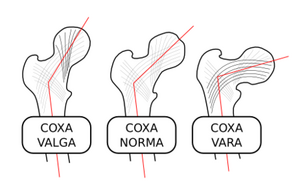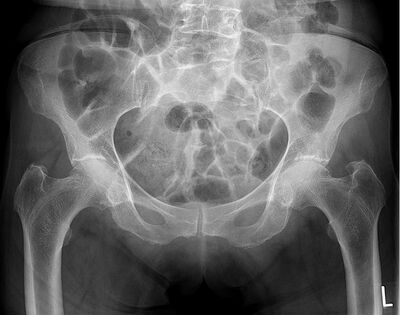Coxa vara adolescentium
Coxa vara adolescentium (epiphyseolysis capitis femoris) is a disease of the proximal growth plate thigh bone, when the head slides backwards and downwards - i.e. into retroversion + varositis.
Occurrence[edit | edit source]
- Before the physiological closure of growth cartilage – most often between 12 and 15 years of age;
- Boys are more often affected (2–4×).
- Bilateral disability is most often reported at around 30%.
Etiology[edit | edit source]
- Not known.
- Endocrine disorders are often cited as provoking factors.
Hormonal imbalance is most often blamed, on the basis of which the growth plate loses its mechanical strength and the shearing forces acting on the growth plate lead to the dislocation of the epiphysis. It has been shown experimentally that growth hormone leads to expansion and mechanical weakening of the growth plate. In contrast, sex hormones reduce the proliferation of cartilaginous cells and thus the height of the growth plate, thereby increasing its mechanical strength. In the clinic, this also corresponds to the fact that up to 70% of CVA sufferers are individuals with Fröhlich's syndrome, in which the production of gonadotropins is reduced at a normal level of STH (Fröhlich's syndrome = adiposogenital dystrophy, obesity, hypogonadism, +/- growth retardation, more often in boys) or, conversely, occurs in tall, slim, fast-growing children with increased STH levels.
- Around a quarter of patients have a history of hip joint injury, falling on their side, or possibly jumping from above.
Clinical picture[edit | edit source]
- mostly gradual, gradually appearing pain, limping when walking, the child spares the limb;
- pain is usually on the inner side of the thigh and knee joint;
- mobility in the hip joint is gradually reduced, especially internal rotation + abduction is significantly limited; adductor contracture;
- with a greater slip, the limb is in external rotation and in a short circuit
- with a greater slip of the head, it is typical that during examination of flexion in the hip joint, the lower extremity rotates itself into external rotation and internal rotation is impossible (Drehman's sign);
- when walking, the patient can then kick the heel of the other leg;
- sometimes an acute slip may also occur, when when falling/jumping from a height, the patient feels a sharp pain in the hip joint and walking is practically impossible;
- in the anamnesis we find out that the child had occasional pain in the hip joint for several days.
Diagnostics[edit | edit source]
- We perform x-ray examination of the hip joints in 2 projections: anteroposterior (AP) and Lauenstein;
- coxa vara adolescentium is divided into 3 groups according to the x-ray image:
- 1. group – slide of the head by 1/3 of the width of the neck, i.e. up to 30°;
- 2. group – slide of the head by 1/3 to 1/2 of the width of the neck, i.e. from 30 to 60°;
- 3. group – slide of the head by more than 1/2 the width of the neck, i.e. over 60°.
Therapy[edit | edit source]
- Always operative, it depends on the size of the slide of the head;
- for the 1st group, we fix the displaced head with a bundle of Kirschner wires (5-6 wires), which we introduce using an X-ray amplifier in the axis of the neck from the area below the greater trochanter (Arries-Dias operation), the wires must sufficiently fix the epiphysis to prevent further displacement of the epiphysis backwards and downwards;
- for the 2nd group a corrective osteotomy of the proximal end of the femur is already necessary - the purpose is to bring the head into contact with the joint socket, valgus, derotation and deflection osteotomies are used - either in the intertrochanteric area (Imhäuser-Weber) or in the area of the lesser trochanter (Southwick).
Complications[edit | edit source]
- in the case of larger slips, various shape changes can occur on the head, which in adulthood leads to an earlier development of arthrosis of the hip joint;
- with repeated attempts at repositioning, or as a result of surgery, acute necrosis of the cartilage can occur - coxitis laminaris, Waldenström's chondrolysis - this necrosis is manifested by pain, flexion and adduction contracture in the hip joint and there is significant limitation of mobility in the hip.
Prognosis[edit | edit source]
- the disease must be considered as prearthrosis (these children may develop earlier coxarthrosis).
Links[edit | edit source]
Related articles[edit | edit source]
References[edit | edit source]
- SOSNA, A. – VAVŘÍK, P.. Základy ortopedie. 1. edition. Triton, 2001. ISBN 80-7254-202-8.
- DUNGL, P.. Ortopedie. 1. edition. Grada Publishing, 2005. ISBN 80-247-0550-8.


